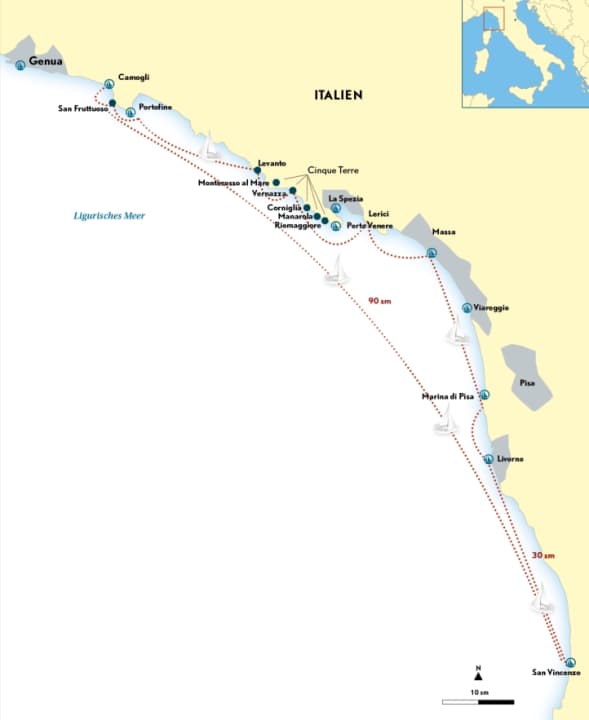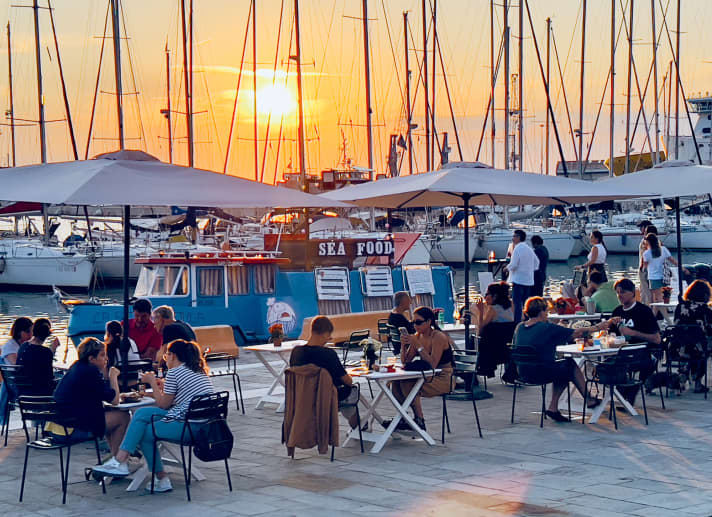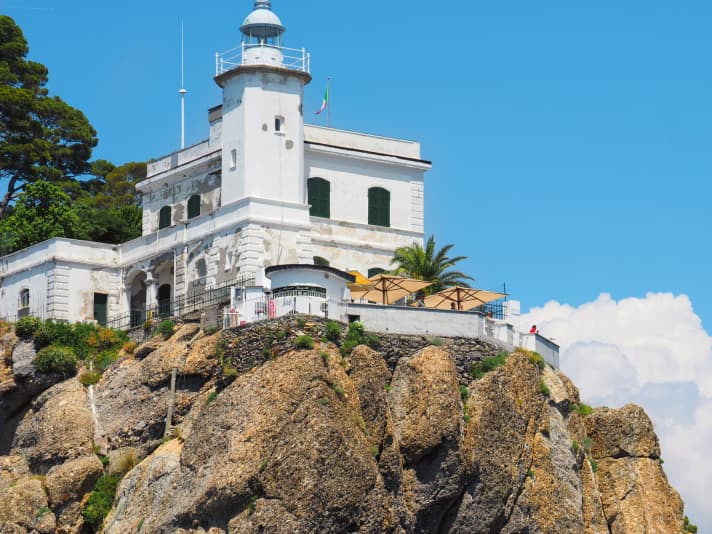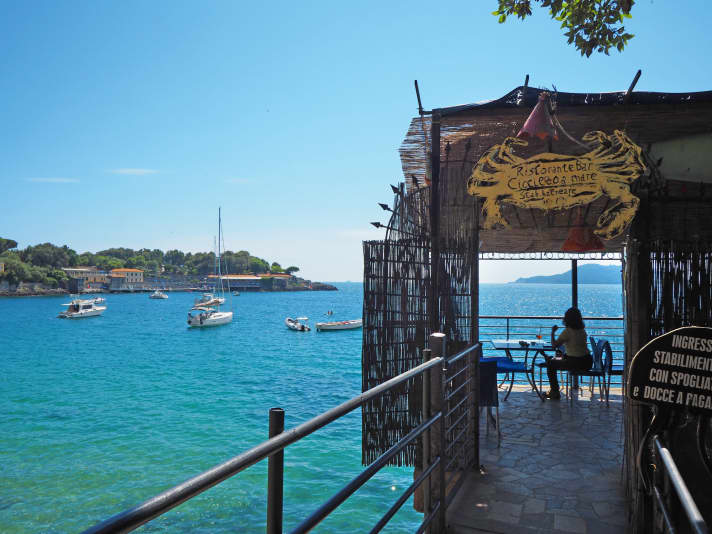Journey: Liguria - a feast for the senses for Italy fans






In this article:
The temptation is great to put the rudder hard to port immediately after leaving the harbour - heading for Elba. Or simply continue straight ahead to Capraia and sail to Corsica the next day. "Most charter guests do exactly that," says Birger Palm from Palm Yachting. Hardly anyone heads in the opposite direction from San Vincenzo, up the Tuscan coast towards Liguria, the Cinque Terre and Portofino. He's never done it himself, admits Palm. But it must be beautiful. Not so crowded. However, the number of anchor bays in the north is limited.
Anyway, we are curious and sailing against the current. Even if the one week we have at our disposal is a bit ambitious for our plans.
Liguria is ideal for short trips
It is just under 90 nautical miles to the Ligurian coast. Possible stopovers are in Livorno or Marina di Pisa. We have the "Ribelle", a Jeanneau Sun Odyssey 439, at our disposal, which does its bit for a speedy passage thanks to its new, fully battened main: the ship sails well. The wind and weather are also favourable, and so the first 30 miles to Livorno are quickly sailed.

We moor at the local yacht club just in time for sundowners. The name sounds classier than the actual conditions: The floating jetties squeak symphonically in the swell of the large harbour basin, the exhaust fumes of several ferries waft through the air as they pass within shouting distance. On the other hand, the harbour staff are remarkably friendly. As are the berth prices: 45 euros for 13 metres, you can't complain about that.
A stroll through the oldest part of Livorno, the Quartiere Venezia, the old warehouse district, is a must. In Little Venice, you can experience pure Italy. Almost only locals are out and about here. In the evenings, people train for rowing regattas in the canals, stroll along the banks and then eat well and cheaply.
For example, Cinque e Cinque, a local speciality in the form of a sandwich filled with vegetables of your choice and a chickpea batter. Followed by a ponce, the typical Livorno mixed drink: a nightcap of coffee, rum, cinnamon and lemon. It is said to have originated in the 17th century after heavy weather caused the cargo in the belly of a ship to be thoroughly mixed up - just like in a cocktail mixer.
From Livorno to Arno
The next day we continue sailing northwards. Marina di Pisa remains to starboard, the conditions are too perfect. We also want to make some distance. Suddenly the colour of the water changes, as if someone had poured a giant cappuccino into the sea. The deep blue azzurro becomes a brownish-beige colour. So clearly delineated as in a colour theory that you can't help but look at your nautical chart and plotter. A sandbank? Or a chemical spill? The answer is quickly obvious: we are standing in front of the mouth of the River Arno.
A little detour is a must. We lower the sails and chug up the river at a crawl over the sand bar. We keep our eyes fixed on the depth sounder. The depths vary in the estuary, depending on the rainfall inland, but they are just right for our boat. Fishing huts on stilts appear on the banks, to which gigantic sinking nets are attached. They can simply be lowered into the river. Fellow sailor Bene imagines he is in Vietnam or Thailand. In any case, the huts make a great photo opportunity.
A number of marinas soon line the southern bank of the Arno. Ideal for a shore excursion to the famous leaning tower. Pisa is just twelve kilometres away from here, and there is also a bus connection. However, we decide not to go sightseeing and prefer to sail on. So back out to sea, which changes colour again a short time later. The dark blue is somehow more calming.
From Arno to Carrara
A long, wild stretch of coast follows. More beach than people. And no parasols anywhere. Slowly, the mountains move closer to the coast: the Apuan Alps, an impressive backdrop. Near Carrara, you can clearly see the quarries from which Michelangelo selected his marble blocks. Among other things, for his sculpture of David, which stands in Florence.
Unfortunately, we arrive a little too late to ask for a berth in the Marina di Carrara. Shortly after 7 pm, the harbour master - rather untypical for Italy - can neither be reached on channel 72 nor by phone. So should we just moor in a free box? We ask the skipper of a local yacht that is just coming in. The answer: "Mi dispiace, è tutto privato." In other words, guest moorings unfortunately have to stay outside; they are all private.
A pity, but no drama, as the thermals have dropped considerably and an offshore wind from the mountains gives us a calm and safe night. There are more than enough good anchorages along the coast of Tuscany.
To the Gulf of La Spezia
This only changes when we reach the Gulf of La Spezia the next morning. The shore becomes rockier. On the starboard side, Tellaro greets us in the finest morning light - a former fishing village that could unofficially be considered the sixth village of the Cinque Terre. However, it is off the beaten track. This is where the more affluent Italians have bought in. Accordingly, the place has a somewhat ghostly appearance. We prefer to sail a few bays further to Lerici. You could hardly drop anchor in a more sheltered spot. We are moored at the foot of an old fort with a view of small and large warships. Various fighter jets fly overhead.
The explanation: there is a military base in La Spezia. Now and again there is live firing. If you're unlucky, the Golfo dei Poeti - the Gulf of Poets, named after the Shelleys and Lord Byron, who settled here in 1820 - is closed off during the exercises. It's easy to understand why when you think of the helicopters, fighter jets, warships and detonations.
Opposite Lerici is Porto Venere - the harbour of Venus. A berth for 43 feet would cost 130 euros a night. The harbour master says there is room. But perhaps it would be better to save the cash on board and drop anchor not far from the mussel farm, with a trip line to be on the safe side. Eleven metres of water are beyond the crew's snorkelling abilities.
Porto Venere
In Porto Venere, colourful houses flank the harbour basin, forming a cinematic backdrop below the Castello Doria. But whether the fairy lights on the houses are necessary? A matter of taste! We think so: Less Disneyland is more Italy. The location of Porto Venere alone: on a headland at the end of the Riviera di Levante. The Chiesa San Pietro sits enthroned on the outermost tip in an exposed location where lighthouses stand elsewhere. A dream. From here you can see the entire Cinque Terre to the north-west.
In 1997, the coastline was declared a World Heritage Site by Unesco. Almost at the same time, the Italian Ministry of the Environment turned it into a national park and designated a marine conservation zone, but this has not had a major impact on sailing along the coast. On the contrary. Murings have been laid out in front of some villages to protect the seabed. This includes just off Vernazza, which is generally regarded as the most beautiful village in the Cinque Terre. More a curse than a blessing, it is correspondingly crowded there.
With a 13-metre yacht, you don't stand a chance in the harbour. From June onwards, the harbour is closed to guests anyway. Even the dinghy engine has to be parked in the basin. It's already busy enough as it is. The harbour is teeming with boats. And people. After a short flying visit, you're almost glad to be back on board the "Ribelle". Conclusion: it's better not to get too close to some beauties.
We spend the evening at the beginning, or rather the end, of the all-too-famous coastal strip: in Levanto. More precisely, in a multi-award-winning pizzeria called "La Picea". Things are much more Italian here.
To Portofino
The next day, Portofino, the most famous fishing village in Europe, is on the programme. Unfortunately, it also has the highest property prices. Once again, in summer there is hardly any chance of getting one of the few guest berths in the harbour. Fortunately, you don't have to. When the crowds of day trippers leave on their motorboats, you can move your yacht to a small bay right next to the harbour. Until then, we pass the time sailing between the various superyachts moored off Portofino.
One of these is the three-masted schooner "Koru". Built in Rotterdam and delivered to Amazon founder Jeff Bezos just this year. Not far away is his second yacht, the "Abeona", which serves as a kind of dinghy. With a helicopter on the stern, of course. Total value of the two ships: almost 600 million dollars! It's almost amazing how close we can sail past them. So close that our charter yacht is reflected in the hull of the giant ships.
After so much luxury, we are drawn to the monastery. Namely to the bay of San Fruttuoso. If you arrive in time, you can still get one of the coveted white murings here. Even though the tranquillity of the former monastery has long since fallen victim to the bathing and excursion industry, the bay is a dream. A harmonious combination of nature and culture. A monastery with beach access. The water in the bay is deep blue. And beneath the surface is a statue of Jesus. Easy to locate: very close to the diving boats that come here during the day.
The exploration of Portofino is postponed. We now know that it's better to visit overly popular places in Italy on weekdays than at the weekend. In the meantime, we make do with Camogli, a few miles further north. The town can be recognised from afar by its multi-storey, colourful house facades. These used to make it easier for fishermen to return home in bad weather.
As an exception, we moor bow-first in the outer harbour basin. The ground at the pier is unclean and the rudder blade could touch down there if the waves hit. A little later, we are immersed in a unique scenery: The town appears to be draped around the inner harbour basin. The church stands directly on the water, the promenade runs above the beach. Countless bars and restaurants are lined up, along with people strolling around and children playing ball. A feast for the senses. All the ingredients for the famous dolce vita. You don't want to leave.
But we still want to see Portofino. Instead of taking an expensive mooring ring, we bring out our anchor and a shore line. We attach it to a ring provided in the rock - perfect! Shortly afterwards, we stroll between dignified estates and the scent of jasmine hedges. Somewhere here, in the almost tropically lush gardens, must be the villa of the German champagne baron Mumm, who made Portofino famous at the beginning of the 20th century. It was only afterwards that the Italian rich and famous also discovered the fishing village and put their luxury stamp on it.
You can take whatever view you like. However, it is difficult to escape the fascination of this place, its inimitable beauty and the whole area in general.
Five tips for going ashore
Livorno
Honest, Italian harbour town. Low berth prices at the Livorno Yacht Club. With a beautiful market hall and the Quartiere Venezia behind the Fortezza Nuova. The best time to visit is in the evening, when the lights are reflected in the canals. Alternatively, you can stroll along the Terrazza Mascagni promenade south of the old town centre. This is particularly popular with locals on Sundays.

Vernazza
Probably the most beautiful place in the Cinque Terre. Since the five villages are no longer only accessible by boat or donkey, but by train, the tranquillity is gone during the day. Whether you spend the night on site at a mooring must be decided according to the weather. Caution is advisable in any case: In our case, a mooring line broke even with a light load.

Portofino
See and marvel and enthuse. However, moorings are rare and expensive. It is better to moor in the small bay north of the harbour with an anchor and shore line. You can reach the road via the small public beach in the bay. Be sure to go to Punta di Portofino (photo) and treat yourself to an aperitivo there. If you take two, you can save yourself dinner thanks to the appetisers served.

Porto Venere
The harbour of Venus is also one of the most beautiful places in Liguria and forms the rugged end of the Riviera Levante as well as the gateway to the Gulf of La Spezia. The view from the Gothic church of San Pietro is spectacular. Afterwards, stop off at "La Medusa" in the small fountain square.

Lerici
Good anchorage below the fortress opposite Porto Venere. A tunnel connects the small beach with the town. There is a weekly market on the promenade on Saturdays. Theoretically, Porto Venere can also be visited from here by ferry.

Information for the charter trip
The precinct
The Ligurian coast stretches from the French border to the Gulf of La Spezia. A distinction is made between the Riviera di Ponente, the part to the west of Genoa, and the eastern part as far as Porto Venere - the Riviera di Levante. This section in the east is known as the Cinque Terre. Due to the Apennine foothills, the coast here is steep and rugged and very popular with hikers. On the other hand, there are hardly any anchorages for boaters. And even at the mooring buoys laid out in many places, it can get very choppy due to the heavy boat traffic, even when there is no wind. There are numerous attractions along the 60 or so nautical miles of the Riviera di Levante, for which you should take at least a week, preferably more.
Navigation
Some stretches of coastline are designated as marine nature reserves, which are categorised into zones (A, B and C). However, this hardly affects sailors; the strict no-sailing areas in zone A are very manageable.
Charter
We were travelling on a Sun Odyssey 439 from Palm Yachting. Prices for a week range between 2,700 and 4,800 euros, depending on the season. To book via www.palm-yachting.it (German is spoken) or via one of the usual agencies. From San Vincenzo, where the charter base is located, it is just under 90 nautical miles to the Gulf of La Spezia, although you can take a pleasant break in Livorno or Marina di Pisa. One week is not enough for the trip, it is better to charter for ten days or two weeks.
Literature & Charts
"Coastal Handbook Italy", Edition Maritim, 69.90 euros, delius-klasing.de. For travelling by land: "Liguria" travel guide, 20.90 euros, Michael Müller Verlag. Map: "NV Atlas Italy IT1: Menton to Elba", 64.99 euros.
Wind & Weather
Liguria has its own microclimate. Thanks to the high mountains, the coast is virtually protected from cold northerly winds. This makes it a very favourable weather area for sailors. The wind near the coast tends to be weak to circulating, especially during the high season, and is rarely stronger than 3 to 4 Beaufort. It can be much more unpleasant in the low season when the Libeccio from the south-west brings a lot of wind and rain. Sheltered anchorages or harbour spots are then in demand and correspondingly rare. As the Libeccio hits the coast almost unchecked, considerable waves can sometimes build up in front of it.

